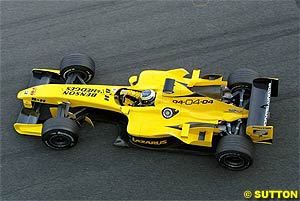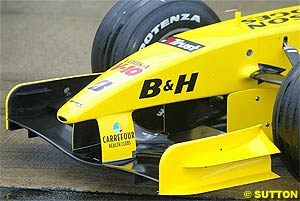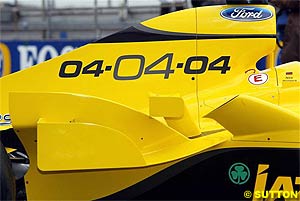
Atlas F1 Technical Writer
The Jordan launch was a low key affair compared to years gone by, with the car simply pushed out of a garage at Silverstone. But has the cash strapped team managed to produce any notable changes to last year's underperforming car? Atlas F1's Craig Scarborough looks at the details of the EJ14
Last year
With Jordan keeping an eye on its budgets, the EJ13 was a progression from the complex and unsuccessful "anteater" EJ12, with many areas of the design being rationalised. Gone were the four-leg twin keels and overly curved nose, and the suspension mounted its torsion bar high rather than a linkage from the rocker transferring the motion to a low mounted torsion bar. Some conventionalities were carried over, such as the sidepod shape, cast alloy gearbox and coil sprung dampers at the rear. New approaches in design included the complex mounted radiators, low-line engine cover and splayed keels.
But the car struggled in its opening tests and races, notably through gearbox problems and oil concerns for the 72-degree Ford engine. These were fixed with an airbox mounted oil tank (deleted by Silverstone), while the gearbox cracking problems were cured with carbon fibre bonded over the suspension mount. Such was the success of this approach that a carbon skin was applied to the whole gearbox. Overall the car was underdeveloped and struggled on despite its unreliable engine, worrying structural failures (rear wing mounts and wishbones) and Bridgestone tyres.
Complicating this mix of technical problems and budget concerns, Jordan suffered the mid-season departure of aerodynamicist Henri Durand followed at season's end by the team's favoured engineer Gary Anderson.
Aero
Bargeboards are still the complex one-piece forward mounted design, using three vanes to turn the air from the front wing around the car. They are now mounted to the chassis with a strut between the wishbones. As part of the forward mounted bargeboard philosophy, the car also runs vertical fences on the splitter as well as horizontal fins in front of the sidepods.
Sidepods return to an old Jordan design with Ferrari-like undercuts on the leading edge, exposing the lower crash structure at floor level. Further similarities extend to the flip up and cooling designs, still adopting the bulky fin-mounted winglet preceded by a cooling chimney. Changes this year see a winglet mounted atop the sidepod behind the chimney, which probably acts as much to extract hot air from the chimney as to add any downforce. It is shaped, as with most teams, to keep its inner profile flat so as not to send any unwanted vortices into the rear wing.
Jordan have opted to run the line of the regulation engine cover all the way to the rear of the car, preferring not to cut off the cover at the axle line. Large blisters are required to hide the rockers and dampers of the rear suspension.
Simplification has been carried out to meet the new rear wing regulation (only two upper elements). A simpler lower beam is only lightly twisted at the endplates to reduce vortices, while the rear wing uses a simple main plane and a curved flap. Jordan have adopted their own take on the rear wing endplate, which curves the top front edge in side view but keeps the rear full length to the rear.
Structure and mechanics
The car now features a raised chassis all the way to the splitter, leaving clear air visible under the chassis behind the front wheels. Under the chassis the weight reduction programme is apparent in the ballasted splitter, which now appears to made solely from metal, which is probably tungsten although Jordan did use steel for some races last year. The sides of the splitter are capped with vertical fences hiding the materials use. The front splitter/ballast forms a separate part from the floor. The other structural variance from the EJ13 is a straight rear edge to the smaller fuel cell.
Unusually, the gearbox is only cast in alloy with no carbon skins, but the rear impact structure is neater and provides the mount for the rear upper wishbone. Also the front of the upper wishbone mounts atop the gearbox and not on its side, creating a single shear mounting, which is theoretically weaker. Rockers operate from the pushrod conventionally and mount a third damper to the rear, with forward facing wheel dampers.
 With a bad run of seasons and funding becoming increasingly an issue, Jordan rolled out their new car for a low-key launch just across the road from their factory at Silverstone. With a new technical line up running the design and operation of the car, the team have high hopes for their evolutionary car.
With a bad run of seasons and funding becoming increasingly an issue, Jordan rolled out their new car for a low-key launch just across the road from their factory at Silverstone. With a new technical line up running the design and operation of the car, the team have high hopes for their evolutionary car.
 Aside from form structural changes under the nose, there is little different on the aerodynamic concept for the EJ14. The front wing now mounts to vertical drop plates, unlike the splayed versions on the EJ13. The wing profile is lightly curved, with a narrow chord across the centre section, but with three gurneys, one wide strip and two small sharks teeth on either side. Front wing endplates follow Jordan's simple profiles from 2003, with no cut outs and a shallow sweep to fit in between the wheels.
Aside from form structural changes under the nose, there is little different on the aerodynamic concept for the EJ14. The front wing now mounts to vertical drop plates, unlike the splayed versions on the EJ13. The wing profile is lightly curved, with a narrow chord across the centre section, but with three gurneys, one wide strip and two small sharks teeth on either side. Front wing endplates follow Jordan's simple profiles from 2003, with no cut outs and a shallow sweep to fit in between the wheels.
 Exhausts are routed unusually wide into the vertical fin on sidepods, exiting through a slot created for both the pipe and a hot air outlet. Otherwise the sidepods do not look to have a particularly slim rear end, although the flip up does distort the view.
Exhausts are routed unusually wide into the vertical fin on sidepods, exiting through a slot created for both the pipe and a hot air outlet. Otherwise the sidepods do not look to have a particularly slim rear end, although the flip up does distort the view.
 Moving away from the variety of twin keel arrangements from the EJ12 end EJ13 the lower wishbone now mounts to a single central keel at the front and to smaller twin keels at the rear, with the team probably in search of stiffness over the widely placed keels used last year. Front wishbones, pushrod and steering arm are all in carbon fibre, and it would appear to be similar at the rear. For ease of access the front third damper runs over the top of the rockers, and is accessed through a hole in the scuttle.
Moving away from the variety of twin keel arrangements from the EJ12 end EJ13 the lower wishbone now mounts to a single central keel at the front and to smaller twin keels at the rear, with the team probably in search of stiffness over the widely placed keels used last year. Front wishbones, pushrod and steering arm are all in carbon fibre, and it would appear to be similar at the rear. For ease of access the front third damper runs over the top of the rockers, and is accessed through a hole in the scuttle.
 This Jordan will use the new 90-degree Cosworth CR-6 engine, with parity in version to Jaguar. Although new developments may appear on either of the teams' car dependant on test schedules, Cosworth aims to deliver the same spec to both teams at all races. With the new wider and lower engine Jordan have needed to develop new exhausts, airbox and cooling systems. The airbox is low like last year, as are the radiators which are placed at a compound angle in the sidepods.
This Jordan will use the new 90-degree Cosworth CR-6 engine, with parity in version to Jaguar. Although new developments may appear on either of the teams' car dependant on test schedules, Cosworth aims to deliver the same spec to both teams at all races. With the new wider and lower engine Jordan have needed to develop new exhausts, airbox and cooling systems. The airbox is low like last year, as are the radiators which are placed at a compound angle in the sidepods.
|
Contact the Author Contact the Editor |
Please Contact Us for permission to republish this or any other material from Atlas F1.
|
Volume 10, Issue 6
Articles
Trial in Absentia
Promise and Deliver?
Technical Analysis: EJ14
2004 Countdown Facts & Stats
Columns
Rear View Mirror
Bookworm Critique
On the Road
Elsewhere in Racing
> Homepage |